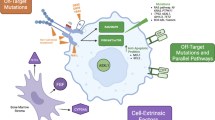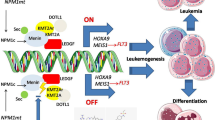Abstract
Purpose
Drug resistance presents a major obstacle for the treatment of some patients with chronic myeloid leukemia (CML). Pro-apoptotic ceramide mediates imatinib-induced apoptosis, and metabolism of ceramide by glucosylceramide synthase (GCS) activity, converting ceramide to glucosyl ceramide, might contribute to imatinib resistance. In this study, we investigated the role of ceramide metabolism by GCS in the regulation of imatinib-induced apoptosis in drug-sensitive and drug-resistant K562 and K562/IMA-0.2 and K562/IMA-1 human CML cells, which exhibit about 2.3- and 19-fold imatinib resistance, respectively.
Methods
Cytotoxic effects of PDMP and imatinib were determined by XTT cell proliferation assay. Expression levels of GCS were determined by RT-PCR and western blot. Intracellular ceramide levels were determined by LC–MS. Cell viability analyses was conducted by Trypan blue dye exclusion assay. Cell cycle and apoptosis analyses were examined by flow cytometry.
Results
We first showed that mRNA and protein levels of GCS are increased in drug-resistant K562/IMA as compared to sensitive K562 cells. Next, forced expression of GCS in sensitive K562 cells conferred resistance to imatinib-induced apoptosis. In reciprocal experiments, targeting GCS using its known inhibitor, PDMP, enhanced ceramide accumulation and increased cell death in response to imatinib in K562/IMA cells.
Conclusion
Our data suggest the involvement of GCS in resistance to imatinib-induced apoptosis, and that targeting GCS by PDMP increased imatinib-induced cell death in drug-sensitive and drug-resistant K562 cells via enhancing ceramide accumulation.







Similar content being viewed by others
Abbreviations
- CML:
-
Chronic myeloid leukemia
- IMA:
-
Imatinib
- MDR:
-
Multiple drug resistance
- K562/IMA-0.2 and K562/IMA-1:
-
K562 cells those were able to grow in the presence of 0.2 and 1 μM Imatinib
- GCS:
-
Glucosylceramide synthase
- GlcCer:
-
Glucosylceramide
- (IC)50 :
-
The concentration of any chemical that inhibits growth by 50%
- XTT:
-
2,3-bis-(2-methoxy-4-nitro-5-sulfophenyl)-2H-tetrazolium-5-carboxanilide
- RT-PCR:
-
Reverse transcriptase-polymerase chain reaction
- Pi:
-
Inorganic phosphate
- LC/MS:
-
Liquid chromatography-mass spectrometry
References
Baran Y, Salas A, Senkal CE, Gunduz U, Bielawski J, Obeid LM, Ogretmen B (2007) Alterations of ceramide/sphingosine 1-phosphate rheostat involved in the regulation of resistance to imatinib-induced apoptosis in K562 human chronic myeloid leukemia cells. J Biol Chem 282:10922–10934
Bonhoure E, Lauret A, Barnes DJ, Martin C, Malavaud B, Kohama T, Melo JV, Cuvillier O (2008) Sphingosine kinase-1 is a downstream regulator of imatinib-induced apoptosis in chronic myeloid leukemia cells. Leukemia 22(5):971–979
Bose R, Verheij M, Haimovitz-Friedman A, Scotto K, Fuks Z, Kolesnick R (1995) Ceramide synthase mediates daunorubicin-induced apoptosis: an alternative mechanism for generating death signals. Cell 82:405–414
Bradshaw DM, Arceci RJ (1998) Clinical relevance of transmembrane drug efflux as a mechanism of multidrug resistance. J Clin Oncol 16:3674–3690
Buchdunger E, Zimmermann J, Mett H, Meyer T, Müller M, Druker BJ, Lydon NB (1996) Inhibition of the abl protein-tyrosine kinase in vitro and in vivo by a 2-phenylaminopyrimidine derivative. Cancer Res 56:100–104
Cabot MC, Giuliano AE, Han TY, Liu YY (1999) Sdz psc 833, the cyclosporine a analogue and multidrug resistance modulator, activates ceramide synthesis and increases vinblastine sensitivity in drug-sensitive and drug-resistant cancer cells. Cancer Res 59:880–885
Dbaibo GS, Pushkareva MY, Rachid RA, Alter N, Smyth MJ, Obeid LM, Hannun YA (1998) P53-dependent ceramide response to genotoxic stress. J Clin Invest 102:329–339
Deininger M (2005) Resistance to imatinib: mechanisms and management. J Natl Compr Canc Netw 3:757–768
Hale AJ, Smith CA, Sutherland LC, Stoneman VE, Longthorne V, Culhane AC, Williams GT (1996) Apoptosis: molecular regulation of cell death. Eur J Biochem 237:884
Hannun YA (1996) Functions of ceramide in coordinating cellular responses to stress. Science 274:1855–1859
Hannun YA, Obeid LM (2002) The ceramide-centric universe of lipid-mediated cell regulation: stress encounters of the lipid kind. J Biol Chem 277:25847–25850
Hegedus T, Orfi L, Seprodi A, Varadi A, Sarkadi B, Keri G (2002) Interaction of tyrosine kinase inhibitors with the human multidrug transporter proteins, mdr1 and mrp1. Biochim Biophys Acta 1587:318–325
Inokuchi J, Jimbo M, Momosaki K, Shimeno H, Nagamatsu A, Radin NS (1990) Inhibition of experimental metastasis of murine lewis lung carcinoma by an inhibitor of glucosylceramide synthase and its possible mechanism of action. Cancer Res 50:6731–6737
Koca E, Haznedaroglu IC (2005) Imatinib mesylate and the management of chronic myeloid leukemia (CML). Turk J Hematol 2(4):161–172
Kok JW, Veldman RJ, Klappe K, Koning H, Filipeanu CM, Muller M (2000) Differential expression of sphingolipids in mrp1 overexpressing ht29 cells. Int J Cancer 87:172–178
Kolesnick RN, Kronke M (1998) Regulation of ceramide production and apoptosis. Annu Rev Physiol 60:643–665
Koybasi S, Senkal CE, Sundararaj K, Spassieva S, Bielawski J, Osta W, Day TA, Jiang JC, Jazwinski SM, Hannun YA, Obeid LM, Ogretmen B (2004) Defects in cell growth regulation by c18:0-ceramide and longevity assurance gene 1 in human head and neck squamous cell carcinomas. J Biol Chem 279:44311–44319
Krystal GW (2001) Mechanisms of resistance to imatinib (sti571) and prospects for combination with conventional chemotherapeutic agents. Drug Resist Updat 4:16–21
Kyogashima M, Inoue M, Seto A, Inokuchi J (1996) Glucosylceramide synthetase inhibitor, d-threo-1-phenyl-2-decanoylamino-3-morpholino-1-propanol exhibits a novel decarcinogenic activity against shope carcinoma cells. Cancer Lett 101:25–30
Lavie Y, Cao H, Bursten SL, Giuliano AE, Cabot MC (1996) Accumulation of glucosylceramides in multidrug-resistant cancer cells. J Biol Chem 271:19530–19536
Li QF, Huang WR, Duan HF, Wang H, Wu CT, Wang LS (2007) Sphingosine kinase-1 mediates BCR/ABL-induced upregulation of Mcl-1 in chronic myeloid leukemia cells. Oncogene 26(57):7904–7908
Liu YY, Han TY, Giuliano AE, Cabot MC (1999) Expression of glucosylceramide synthase, converting ceramide to glucosylceramide, confers adriamycin resistance in human breast cancer cells. J Biol Chem 274:1140–1146
Liu YY, Han TY, Giuliano AE, Hansen N, Cabot MC (2000) Uncoupling ceramide glycosylation by transfection of glucosylceramide synthase antisense reverses adriamycin resistance. J Biol Chem 275:7138–7143
Lucci A, Cho WI, Han TY, Giuliano AE, Morton DL, Cabot MC (1998) Glucosylceramide: a marker for multiple-drug resistant cancers. Anticancer Res 18:475–840
Mahon FX, Deininger MW, Schultheis B, Chabrol J, Reiffers J, Goldman JM, Melo JV (2000) Selection and characterization of bcr-abl positive cell lines with differential sensitivity to the tyrosine kinase inhibitor sti571: diverse mechanisms of resistance. Blood 96:1070–1079
Marsh NL, Elias PM, Holleran WM (1995) Glucosylceramides stimulate murine epidermal hyperproliferation. J Clin Invest 95:2903–2909
Myrick D, Blackinton D, Klostergaard J, Kouttab N, Maizel A, Wanebo H, Metha S (1999) Paclitaxel-induced apoptosis in jurkat, a leukemic t cell line, is enhanced by ceramide. Leuk Res 23:569–578
Nicholson KM, Quinn DM, Kellett GL, Warr JR (1999) Preferential killing of multidrug-resistant kb cells by inhibitors of glucosylceramide synthase. Br J Cancer 81:423–430
Ogretmen B, Hannun YA (2004) Biologically active sphingolipids in cancer pathogenesis and treatment. Nat Rev Cancer 4:604–616
Ogretmen B, Schady D, Usta J, Wood R, Kraveka JM, Luberto C, Birbes H, Hannun YA, Obeid LM (2001) Role of ceramide in mediating the inhibition of telomerase activity in a549 human lung adenocarcinoma cells. J Biol Chem 276:24901–24910
Okazaki T, Kondo T, Kitano T, Tashima M (1998) Diversity and complexity of ceramide signalling in apoptosis. Cell Signal 10:685–692
Perales M, Cervantes F, Cobo F, Montserrat E (1998) Non-hodgkin’s lymphoma associated with gaucher’s disease. Leuk Lymphoma 31:609–612
Piskin O, Ozcan MA, Ozsan GH, Ates H, Demirkan F, Alacacioglu I, Undar B (2007) Synergistic effect of imatinib mesylate and fludarabine combination on Philadelphia chromosome-positive chronic myeloid leukemia cell lines. Turk J Haematol 24:23–27
Robertson LE, Chubb S, Meyn RE, Story M, Ford R, Hittelman WN, Plunkett W (1993) Induction of apoptotic cell death in chronic lymphocytic leukemia by 2-chloro-2′-deoxyadenosine and 9-beta-d-arabinosyl-2-fluoroadenine. Blood 81:143–150
Sawai H, Okazaki T, Takeda Y, Tashima M, Sawada H, Okuma M, Kishi S, Umehara H, Domae N (1997) Ceramide-induced translocation of protein kinase c-delta and -epsilon to the cytosol implications in apoptosis. J Biol Chem 272:2452–2458
Sietsma H, Veldman RJ, Kolk D, Ausema B, Nijhof W, Kamps W, Vellenga E, Kok JW (2000) 1-phenyl-2-decanoylamino-3-morpholino-1-propanol chemosensitizes neuroblastoma cells for taxol and vincristine. Clin Cancer Res 6:942–948
Spinedi A, Bartolomeo SD, Piacentini M (1998) Apoptosis induced by n-hexanoylsphingosine in chp-100 cells associates with accumulation of endogenous ceramide and is potentiated by inhibition of glucocerebroside synthesis. Cell Death Differ 5:785–791
Sultan I, Senkal CE, Ponnusamy S, Ponnusamy S, Bielawski J, Szulc Z, Bielawska A, Hannun YA, Ogretmen B (2006) Regulation of the sphingosine-recycling pathway for ceramide generation by oxidative stress, and its role in controlling c-myc/max function. Biochem J 393:513–521
Walz C, Sattler M (2006) Novel targeted therapies to overcome imatinib mesylate resistance in chronic myeloid leukemia (cml). Crit Rev Oncol Hematol 57:145–164
Acknowledgments
This work was supported by research grants from the National Institutes of Health to BO (CA-088932, DE-016572, and CA097132).
Conflict of interest
We, the authors of the manuscript, do not have any conflict of interest. We alone are responsible for the content and writing of the paper.
Author information
Authors and Affiliations
Corresponding author
Rights and permissions
About this article
Cite this article
Baran, Y., Bielawski, J., Gunduz, U. et al. Targeting glucosylceramide synthase sensitizes imatinib-resistant chronic myeloid leukemia cells via endogenous ceramide accumulation. J Cancer Res Clin Oncol 137, 1535–1544 (2011). https://doi.org/10.1007/s00432-011-1016-y
Received:
Accepted:
Published:
Issue Date:
DOI: https://doi.org/10.1007/s00432-011-1016-y




